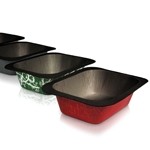Get ready for the new board tray

US-based director of cookware packaging solutions Chris Brady said the firm's polyester-coated pressed paperboard SmartFare tray was both dual ovenable and hermetically sealable as modified atmosphere packaging (MAP).
MWV had already run through proof-of-concept trials in filling, sealing, distribution and retail in the UK. "Now we're in discussions regarding an extended three-to-four-month in-store trial," he said.
While frozen ready meals dominate the North American market, the UK is seen as the test bed for short shelf-life products. "The entire US chilled ready meals market is just one fifth the size of the UK's," Brady explained.
Price-wise, according to MWV, there will be a "slight premium" compared with plastics. "We'll probably be a bit cheaper than aluminium, but we don't want to chase the value ranges," Brady said. "The pack plays nicely in the premium space."
He drew a parallel with the MAP-capable board sandwich packs introduced a few years ago. "This enabled you to put a lot of branding and information on the outside. There was explosive growth in the premium segment," he said, arguing that a board tray offers similar opportunities.
At heatseal specialist Proseal, director Rob Hargreaves said trials run with the MWV pressed board tray achieved a hermetic seal.
"Future demand for board trays will grow strongly," he said. Of the systems available, he added: "There's more than one way to skin a cat, and I don't think anyone's come up with the Holy Grail yet."
One of the issues has been the flexibility of different plastics. "There are polymers that we've consistently been able to heatseal on coated board, but they've tended not to be ovenable ones," says Hargreaves. Polyester, used on ovenable boards, creates a relatively inflexible surface for sealing.
Hargreaves' personal preference for folded board is for both practical and aesthetic reasons. "With pressed board, you need a lot of pressure at the forming stage to get out all the folds," he says. "And if you don't, you can end up getting a capillary action on them."
As the MWV example shows, hermetic seals are possible on pressed board.
Cost issues have stymied many projects involving ovenable, hermetically-sealed board trays. But Hargreaves believes that, in today's climate, more efficient packaging combined with retailer-driven environmental considerations will help ovenable fibre-based packs to carve out a substantial niche.












